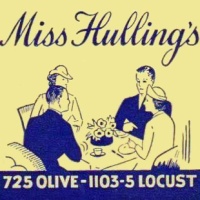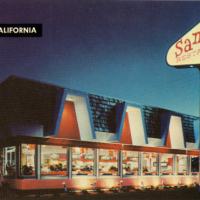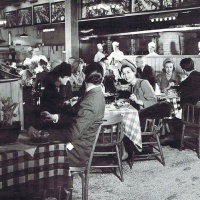Life in the 19th century was chaotic and unpredictable in so many respects, but the weird and eventful life and restaurant career of the highly enterprising Mark Langdon Winn, with its succession of ups, downs, and strange twists, would stand out in any century.
As far as his many business schemes went, he never stuck with any of them for long, restaurants included. He bounced around Maine, Boston, New York City, Albany NY, San Francisco, Virginia City NV, and finally back to New York City where he died in 1881. His San Francisco restaurants were the most successful of his enterprises, but despite their promise he held onto them only for about six years.
Before going to California he owned two grocery stores in Boston. Next he went to New York City where in 1843 and 1844 he manufactured and sold a cure-all product called Winn’s Irish Vegetable Relief Candy, good for “weakness of the chest and lungs, liver complaint(s), asthmatic affection, impurities of the blood, dyspepsia and all bowel complaints.”
Maybe restless, disappointed by candy sales, or lured by gold, he took off for San Francisco in 1849, age 34, after leaving Albany where his wife and children remained for another couple of years. Borrowing money from a shipmate upon arrival, he began making candy and peddling it in the streets. After a short time he had enough money to open a confectionery with a partner. Before long he was running the business solo and had added bakery goods and simple meals to his offerings.
Fires were frequent occurrences in San Francisco and he was burned out at both of his initial locations in less than a year. In 1851 he opened his principal restaurant on Long Wharf, calling it Winn’s Fountain Head. Despite the abundance of eating places in the city, it rose to prominence rapidly due to its respectability, cleanliness, and relatively low prices. It was unique in heavy-drinking San Francisco for providing no alcoholic beverages. Winn was a dedicated temperance advocate, always emphasizing the cause in his frequent, wordy newspaper advertisements that often contained sermons on the evils of drink.
The Fountain Head was not fancy. Long Wharf (aka Commercial Street) was hardly a fine location. It was a busy street without sidewalks, filled with liquor saloons, gambling dens, and all-night stores. It vibrated with “a heterogeneous crowd” of carriages, horses, carts, and pedestrians. A writer in the March 1854 issue of The Pioneer wondered “Why there are not a dozen or two broken necks there daily.”
The Fountain Head was open seven days a week from 6 a.m. to midnight, with a menu that included a wide range of meats and vegetables, along with puddings bearing such homely names as Aunt Sally’s and Cousin Jane’s. According to a ca. 1853 menu, an order of roast beef, veal, or corned beef and cabbage cost 25c, while most vegetables were 12c.
According to the city’s Commercial Advertiser in April, 1854, the Winn enterprises — by then comprising the main Fountain Head restaurant and a more elegant “Branch” welcoming women with fancy desserts – had attained the pinnacle of success. Together, the story reported, the two places served 3,000 patrons daily, taking in $57,000 a month, and paying out monthly as much as $1,600 for advertising, $8,000 for meat, $4,000 for milk, $3,000 for potatoes, and $2,000 for ice.
But this account was misleading because only a few months later Winn went into bankruptcy.
Following bankruptcy he started up at a new address, combining the Fountain Head and its Branch into one. But things soon turned sour again. In Spring 1856, he and his new business partner dissolved their partnership with the partner taking over the business. Almost immediately after that, Winn’s wife Eliza took advantage of a California law that allowed women to run businesses independently, declaring that she would carry on the “Fountainhead Confectionery and Steam Candy Manufactory” in her name. It appears she continued to run the business of making and selling baked goods and confectionery until 1859. He may have briefly tried to make a comeback at his original address, but in 1859 the Fountain Head on Commercial Street and a confectionery run by Eliza Winn were put up for sale.
Years later, in a Poughkeepsie NY newspaper story of 1878, Mark Winn would blame the failure of his San Francisco restaurants on employees who robbed him. “Every man I employed was a thief,” he said, singling out his secretary, cashier, and cook. With honest help, he claimed, “I would have been worth a half a million of dollars.”
But the Winns’ western odyssey wasn’t over after leaving San Francisco. In 1860 they moved to the boomtown Virginia City, Nevada, where silver had just been discovered. There, Mark Winn struck silver, opened a restaurant and confectionery called Winn’s Fountain Head, Jr., and invested in a hotel. The hotel soon relocated to another city in Nevada and he lost his investment. The fate of the restaurant is unknown but it did not achieve fame as he had done in San Francisco [1864 advertisement]. He tried to sell shares in his silver mine, advertising that “there is no doubt that within the next six months a fair dividend will be made to the stockholders.”
Apparently he didn’t strike it rich, though, because after five years in Virginia City he filed for insolvency and the Winns returned to San Francisco where he began work on the invention of a shampooing device that was patented in 1871 [shown above].
Next, the couple moved to New York City where he deteriorated rapidly, living in destitution and displaying signs of paranoia that had been in evidence as far back as 1854 when he referred to his “enemies” in an advertisement for the Fountain Head. On one occasion he was arrested as a public nuisance, wandering the streets of New York wearing “armor” and a tin helmet (possibly the shampooing device?) while distributing religious tracts. He spent his final days in the Alms House on Blackwell Island where he was described as suffering from “religious mania.” It also came out that his father had been an alcoholic.
Despite the uneven contours of his career as a restaurateur, Winn’s Fountain Head has become a subject of interest, often mentioned positively in a number of books and articles that tell of San Francisco’s early history. It’s presented as a triumphal success, when really it’s a boom and bust story sadly common in the restaurant business.
© Jan Whitaker, 2022











































 It's great to hear from readers and I take time to answer queries. I can't always find what you are looking for, but I do appreciate getting thank yous no matter what the outcome.
It's great to hear from readers and I take time to answer queries. I can't always find what you are looking for, but I do appreciate getting thank yous no matter what the outcome.


